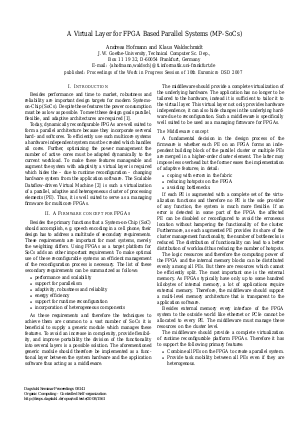A Virtual Layer for FPGA Based Parallel Systems (MP-SoCs)
Authors Andreas Hofmann, Klaus Waldschmidt
-
Part of:
Volume:
Dagstuhl Seminar Proceedings, Volume 8141
Part of: Series: Dagstuhl Seminar Proceedings (DagSemProc) - License:
 Creative Commons Attribution 4.0 International license
Creative Commons Attribution 4.0 International license
- Publication Date: 2008-07-23
File

PDF
DagSemProc.08141.4.pdf
- Filesize: 48 kB
- 2 pages
Document Identifiers
Metrics
- Access Statistics
-
Total Accesses (updated on a weekly basis)
0PDF Downloads0Metadata Views
Abstract
Besides performance and time to market, robustness and reliability are important design targets for modern Systemson- Chip (SoCs). Despite these features the power consumption must be as low as possible. To meet these design goals parallel, flexible, and adaptive architectures are required [1]. Today, dynamically reconfigurable FPGAs are well suited to form a parallel architecture because they incorporate serveral hard- and softcores. To efficiently use such multicore systems a hardware independent system must be created which handles all cores. Further, optimizing the power management the number of active cores must be adapted dynamically to the current workload. To make these features manageable and augment the system with adaptivity a virtual layer is required which hides the – due to runtime reconfiguration – changing hardware system from the application software. The Scalable Dataflow-driven Virtual Machine [2] is such a virtualization of a parallel, adaptive and heterogeneous cluster of processing elements (PE). Thus, it is well suited to serve as a managing firmware for multicore FPGAs.
Cite As Get BibTex
Andreas Hofmann and Klaus Waldschmidt. A Virtual Layer for FPGA Based Parallel Systems (MP-SoCs). In Organic Computing - Controlled Self-organization. Dagstuhl Seminar Proceedings, Volume 8141, pp. 1-2, Schloss Dagstuhl – Leibniz-Zentrum für Informatik (2008)
https://doi.org/10.4230/DagSemProc.08141.4
BibTex
@InProceedings{hofmann_et_al:DagSemProc.08141.4,
author = {Hofmann, Andreas and Waldschmidt, Klaus},
title = {{A Virtual Layer for FPGA Based Parallel Systems (MP-SoCs)}},
booktitle = {Organic Computing - Controlled Self-organization},
pages = {1--2},
series = {Dagstuhl Seminar Proceedings (DagSemProc)},
ISSN = {1862-4405},
year = {2008},
volume = {8141},
editor = {Kirstie Bellman and Michael G. Hinchey and Christian M\"{u}ller-Schloer and Hartmut Schmeck and Rolf W\"{u}rtz},
publisher = {Schloss Dagstuhl -- Leibniz-Zentrum f{\"u}r Informatik},
address = {Dagstuhl, Germany},
URL = {https://drops.dagstuhl.de/entities/document/10.4230/DagSemProc.08141.4},
URN = {urn:nbn:de:0030-drops-15610},
doi = {10.4230/DagSemProc.08141.4},
annote = {Keywords: }
}
